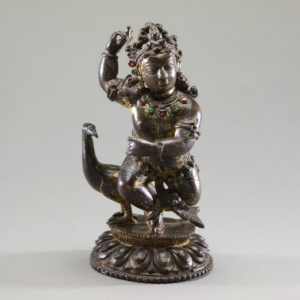
Our latest exhibition, Nepalese Seasons: Rain and Ritual, is based on the cyclical nature of the monsoons. Throughout the year, the indigenous people of the Kathmandu Valley (Newars) perform various rituals and festivals in order to ensure the cycles of the seasons remain predictable and dependable.
In the earliest forms of Hinduism, the Vedic texts considered clouds and rivers to be goddesses, due to water’s association with life and fertility. During the autumn Gathamuga festival, celebrated in early August in Nepal this year, Newars conduct rituals to “impregnate” the skies in order to make sure they give birth to the monsoon rains nine lunar months later. The festival is also a time to dispel certain spirits that are associated with agriculture and the seasons.
Dispelling Spirits
The Kathmandu Valley has always been prized for its agricultural abundance. In fact, it was considered so fertile that traditionally the population of the valley wasn’t large enough to work the land to its full potential. Newars would instead perform tantric rituals, inviting spirits to help them tend the fields and rice paddies. However, once the fields are fully tended, the spirits can become restless and dangerous. To rid the valley of the unwanted spirits, the Newars make large ithyphallic effigies out of reeds, providing them with offerings of money and food to placate their unpredictable ways. Once the festival is over, the effigies are burned, sending the spirits back from where they came.
Sky Impregnation and Resetting the Cycle
Along with the straw effigies, the Newars of Bhaktapur (one of the three major cities of the Kathmandu Valley) create a large clay phallus to mark the beginning of the sky’s next impregnation. After the festival, some of the clay from the phallus is used to make goddess masks for ritualized dances performed throughout the next nine lunar months. The skies then give birth to the “rain babies,” represented by the deity of Kumara (below). Once the rains begin, the masks are laid peacefully to rest by cremation as the farmers once again invoke spirits to help them with their planting. This marks the beginning of the annual cycle.

Visit Nepalese Seasons: Rain and Ritual to learn more about how the country’s dependence on monsoon rain continues to play an important role in its social culture and art.
Add Your Thoughts
Comments are moderated, and will not appear on this site until the Rubin has approved them.


